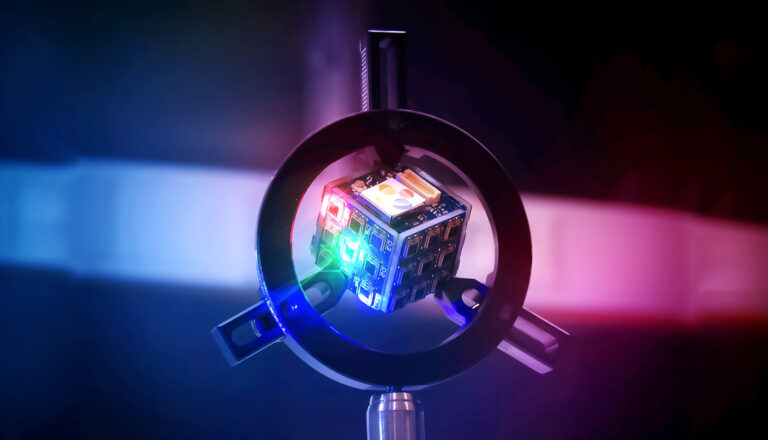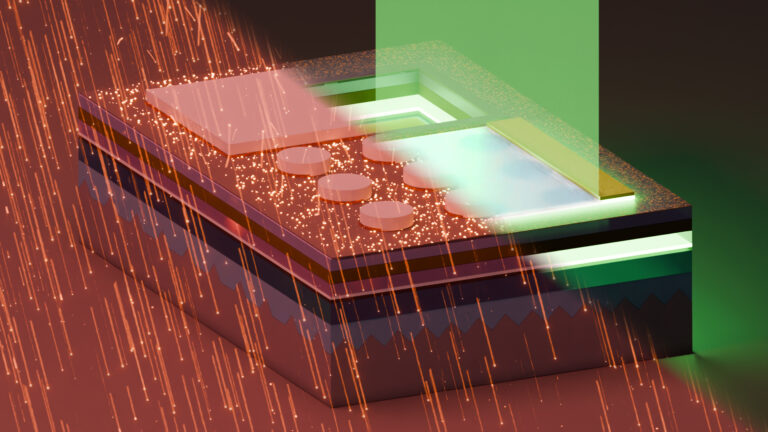Electrical Engineering
A smoother route to smart sensors
Growing high-quality films of hybrid perovskite materials takes solution-processed phototransistors to new levels of performance.


Solar technology will benefit from innovation in phototransistors.
© 2015 KAUST
Low-light cameras and optoelectronic devices stand to benefit from an innovative photoactive thin film developed by KAUST researchers1. The technology uses a simple and effective deposition procedure that turns hybrid organic–inorganic light-harvesting crystals into low-cost phototransistors with super-fast response rates and significant current amplification.
Phototransistors are designed to generate large amounts of charge carriers—either negatively charged electrons or positively charged holes—when exposed to light. These devices can amplify initial signals up to hundreds of thousands of times with very little background noise by controlling how these carriers move through a channel using a gate electrode. Phototransistors with the highest amplification factors, however, are among the most expensive to manufacture.
Tom Wu and colleagues from the Material Science and Engineering Program at KAUST investigated an alternative approach based on methylammonium lead halide compounds. These organic–inorganic materials can be dissolved into liquids and then cast into thin films using a straightforward spin coating technique. A low-temperature treatment then crystallizes the film into a “perovskite”-type structure that can photogenerate numerous charge carriers with high mobility and long lifetimes.
Spin-coated films usually have a rough surface that leaves devices with sub-optimal mobility and weak gate tuning effects.
“The perovskite film quality is the key to achieving high performance in phototransistors,” noted Wu.
The researchers used a two-step vapor-assisted process to improve film deposition. First, they spin-coated a lead halide precursor solution on to a silicon substrate and then exposed the material to methylammonium iodide gas at temperatures of 150 degrees Celsius. This reaction led to perovskite-structure films with smooth and defect-free surfaces and uniform crystal grain sizes—all ideal characteristics for light-based sensing.
After coating the perovskite film with a protective polymer coating, Wu and his team tested the device charge transport characteristics under dark and illuminated conditions. The high-quality film structure had a striking impact—light detection occurred within 10 microseconds, charge carrier mobility increased considerably over previous attempts and the current produced per Watt of incident light energy proved to be among the largest values ever reported for phototransistors.
Intriguingly, the organolead film could transport both electrons and holes through its gate-modulated channel, which could enable device designers to integrate complementary circuits. The team could also tweak device mobility by altering channel lengths or incorporating different halides into the perovskite structure.
“These findings open doors for employing such solution-processed perovskites in a wide range of optoelectronic applications,” added Wu.
References
- Li, F., Ma, C., Wang, H., Hu, W., Yu, W. et al. Ambipolar solution-processed hybrid perovskite phototransistors. Nature Communications 6, 8238 (2015). | article
You might also like

Computer Science
Sweat-sniffing sensor could make workouts smarter

Electrical Engineering
New tech detects dehydration by touching a screen

Electrical Engineering
A new interface for efficient electronics

Electrical Engineering
Artificial neurons enable neuromorphic computing with light

Electrical Engineering
Narrow-linewidth lasers bring low-noise answer

Electrical Engineering
Octopus suckers inspire sticky medical patch

Electrical Engineering
Powering the future of the Internet of Things

Computer Science



